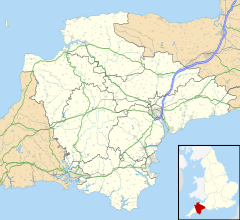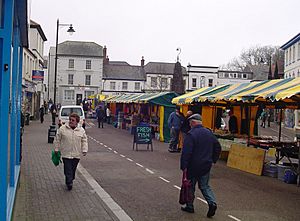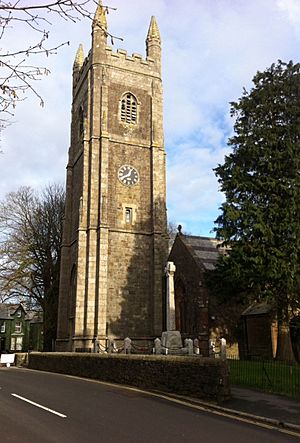Holsworthy facts for kids
Quick facts for kids Holsworthy |
|
|---|---|
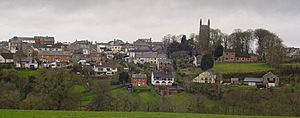 Town View |
|
| Population | 2,641 (2011 Census) |
| Civil parish |
|
| District |
|
| Shire county | |
| Region | |
| Country | England |
| Sovereign state | United Kingdom |
| Post town | HOLSWORTHY |
| Postcode district | EX22 |
| Dialling code | 01409 |
| Police | Devon and Cornwall |
| Fire | Devon and Somerset |
| Ambulance | South Western |
| EU Parliament | South West England |
| UK Parliament |
|
Holsworthy is a lively market town and civil parish in the Torridge area of Devon, England. It's about 36 miles (58 km) west of Exeter. The River Deer, which flows into the River Tamar, forms the western edge of the parish. The village of Brandis Corner is also part of this area. In 2011, Holsworthy had a population of 2,641 people, which grew to an estimated 3,287 by 2019.
Contents
- History of Holsworthy
- How Holsworthy is Governed
- Geography of Holsworthy
- Population Changes
- Holsworthy's Economy
- Culture and Community Life
- Religious Sites
- Holsworthy in World War Two
- Education in Holsworthy
- Media and News
- Sports and Fun
- Getting Around Holsworthy
- Famous People from Holsworthy
- Images for kids
- See also
History of Holsworthy
What's in a Name?
The name "Holsworthy" likely means "Heald's enclosure." It comes from an old English name, "Heald" or "Healda," combined with "-worthig," which means an enclosed farm or estate. Another idea is that it comes from the Old English word "heald," meaning a slope or incline.
Over time, the name has been spelled in many ways, like Haldeword in 1086, and later Halleswrthia or Holdesworthe.
Who Owned Holsworthy?
Holsworthy is mentioned in the Domesday Book of 1086, a famous survey of England. Back then, it was called Haldeword.
The town's ownership changed hands many times throughout history. It was once owned by Earl Harold, then by William I. Later, it was given to different noble families, including the Martyns and the Audleys. Eventually, it became part of the Crown's lands.
In 1347, King Edward III gave Holsworthy to his son, John of Gaunt, 1st Duke of Lancaster. In 1621, Sir John Speccot became the lord of the manor. Later, the Prideaux family owned it, and then it was sold to Thomas Pitt, 1st Earl of Londonderry around 1713. His family, the Earls Stanhope, owned it until 1932. That year, the Holsworthy Urban District Council bought the rights, making the council the lords of the manor!
In 1614, King James I gave Holsworthy a special permission (a charter) to hold an annual fair. During the English Civil War, Holsworthy was held by the Royalists. But in 1646, Sir Thomas Fairfax's forces took control of the town.
During the Second World War, there was a Prisoner of War Camp (No. 42) just north of the town. German and Italian prisoners worked as farm labourers there.
How Holsworthy is Governed
The earliest way Holsworthy was governed was through a Court Leet. This was a very old type of court in English law. It was led by the Portreeve, who was like the town's chief leader since Saxon times. This court handled small crimes and local matters, like collecting taxes from traders.
However, the powers of the Portreeve and Court Leet ended when modern courts and parish councils were created.
On April 1, 1900, Holsworthy parish was divided. The town became Holsworthy Urban District, and the surrounding areas became Holsworthy Hamlets. These councils later joined others to form the new Torridge District in 1974.
Today, Holsworthy has a Town Council with 12 councillors. They choose a mayor each year. The council looks after local services, like footpaths, parks, gardens, and the war memorial. They also run the weekly Pannier Market and the "Holsworthy in Bloom" competition.
Geography of Holsworthy
Holsworthy is located in the western part of the Torridge District in Devon. It's about 190 miles (306 km) from London and 36 miles (58 km) from Exeter. The town sits where the A388 and A3072 roads meet.
The town centre is about 140 meters (459 feet) above sea level. The highest point in the parish is 144 meters (472 feet). The River Deer, a branch of the River Tamar, forms the western border of the parish.
The rocks under Holsworthy are mostly "Bude Formation." These are sedimentary rocks that formed during the Carboniferous period.
Population Changes
The population of Holsworthy has changed a lot over the years. In 1801, there were 1,045 people. It grew steadily to 1,857 by 1841. Then, it dropped to 1,371 by 1901.
After that, the population slowly increased to 1,748 in 1971. It dipped slightly in 1981 but then grew very quickly to 2,641 by 2011. This was a big increase of over 60% in just 30 years!
| Year | 1801 | 1811 | 1821 | 1831 | 1841 | 1851 | 1861 | 1871 | 1881 | 1891 |
|---|---|---|---|---|---|---|---|---|---|---|
| Population | 1,045 | 1,206 | 1,440 | 1,628 | 1,857 | 1,833 | 1,724 | 1,645 | 1,716 | 1,960 |
| Year | 1901 | 1911 | 1921 | 1931 | 1939 | 1951 | 1961 | 1971 | 1981 | 1991 |
| Population | 1,371 | 1,499 | 1,416 | 1,403 | 1,355 | 1,550 | 1,618 | 1,748 | 1,645 | 1,892 |
| Year | 2001 | 2011 | ||||||||
| Population | 2,256 | 2,641 |
Holsworthy's Economy
Holsworthy is known for having one of the biggest livestock markets in South West England. This market was in the same spot from 1905 until 2014. Then, the land was sold for shops and homes, and the market moved to a new location outside of town.
Holsworthy is also home to a special facility that turns dairy farm animal waste (slurry) into biogas. This is a type of clean energy. It's the only one of its kind in the UK! There are plans to use this plant to provide cheap heating to homes in the town.
The town is part of the "Ruby Country," which includes 45 parishes around Holsworthy and Hatherleigh. These two towns were at the center of the 2001 Foot and Mouth Disease outbreak. This disease affected farms, and many local businesses struggled. Because of this, the Ruby Country Initiative was started. It's a group that works to make the local economy stronger and create a unique identity for the area.
Culture and Community Life
Local Traditions and Events
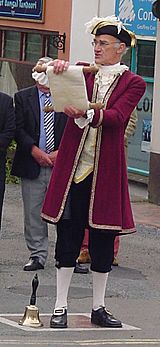
Holsworthy holds its special St Peter's Fair for four days in July. This fair happens eleven days after St Peter's feast day (June 29). On the first day, the town crier reads out the 1614 charter from King James I that allowed the fair to happen. This takes place where the "Great Tree of Holsworthy" once stood in Stanhope Square. A brass plaque in the road marks this spot.
A unique tradition at the fair is the annual "Pretty Maid" presentation. This happens at noon on the first day. No one knows who she is until she appears from the church tower! This tradition comes from a gift left in a will by Reverend Thomas Meyrick in 1841. Part of his gift was to pay £2 10s to a young, single woman under 30 who was considered the "most deserving, most handsome, most noted for her qualities and attendance at church."
The Holsworthy and Stratton Agricultural Show is a big event for the town and local farmers. It started in 1883. After the Second World War, a permanent showground was bought. The show used to be in May, but now it's held in August, just outside Holsworthy.
There's also a half-marathon called the Ruby Run in June. It goes between Holsworthy and Hatherleigh. The starting town changes each year. Many runners from across the South West take part.
The Holsworthy Vintage Vehicle and Engine Rally is a two-day event that began in 1987. It brings in exhibitors and visitors from a wide area. It's held on the last Saturday and Sunday of June.
The annual November Carnival started in 1900. It replaced the older Guy Fawkes and bonfire celebrations.
Holsworthy is twinned with Aunay-sur-Odon, a town in France. People from both towns visit each other in different years.
Community Places
In the middle of the town square, you'll see a stone Market Cross. This cross shows that the town had the right to hold a market and trade. The original cross on top broke off a long time ago and has been replaced with a fancy lamp.
Holsworthy Community Hospital is located north of the town. It was built in 1991 and has one ward for patients and an outpatient department. Next to it is the Holsworthy Medical Centre, which serves the town and nearby villages. In 2014, "The Long House" was built here. It's a center that provides care and support for patients closer to their homes.
Stanhope Park is a large park, about 8 acres (3.2 hectares) in size. It was given to the town by James Stanhope, 7th Earl Stanhope. The town's cricket and bowling clubs are located here. Since 2012, it has been protected as a recreational space forever. A new play park was opened in 2014. The park is also used by Holsworthy Primary School and Holsworthy College for sports and learning.
Holsworthy Library is on North Road, across from the parish church.
Religious Sites
St Peter's and St Paul's Church
The parish church of St Peter's and St Paul's is a very old and important building. The first church on this spot was probably built around 1130. A larger church was built around 1250.
In the late 1800s, the church was renovated. The 15th-century tower is 85.75 feet (26.14 m) tall and has eight bells.
The south porch has parts of the original Norman building. You can see a carved stone holy water stoup and a carved stone panel showing the Agnus Dei (Lamb of God).
The church has several beautiful stained-glass windows. The organ is very old and is said to have come from Chelsea Old Church in London. It was moved to Holsworthy in 1865.
Interestingly, this church is one of the few in the country to show the Devil in its stained glass. It's also famous because of Samuel Sebastian Wesley's music, Holsworthy Church Bells.
Methodist Church
The Methodist Church on Bodmin Street opened on April 28, 1910. It's a beautiful building, built in 1909–1910 by local builders. It has a tall, eight-sided tower with a spire.
The church's front is made of Bath stone. Inside, it has a special ceiling called a "hammerbeam roof" and an old organ from 1887. Some of its stained-glass windows have a lovely Art Nouveau style.
Catholic Church
There used to be a Catholic church in Holsworthy called St Cuthbert Mayne Chapel. It closed in 2005. Since then, the Catholic community has held their services at the Holsworthy parish church.
Holsworthy in World War Two
During World War II, there was a POW Camp (Prisoner of War Camp) near Holsworthy. Inside the Church of St Peter today, you can see a crucifix carved by a German prisoner of war. There are also two hand-painted stained-glass windows made by Italian prisoners. These items came from a hut that served as their Roman Catholic chapel.
Education in Holsworthy
The schools in Holsworthy include Holsworthy Community College (for older students) and Holsworthy CE Primary School (for younger students).
Media and News
For TV, Holsworthy gets local news from BBC South West and ITV West Country.
Local radio stations include BBC Radio Devon and Heart West. You can also pick up BBC Radio Cornwall. There's also a digital radio station called NCB Radio.
The town has its own local newspaper, the Holsworthy Post, which comes out every Thursday.
Sports and Fun
Holsworthy has a non-League football club called Holsworthy A.F.C. They play their games at Upcott Field.
The Holsworthy Cricket Club has been around since 1873.
Getting Around Holsworthy
Holsworthy has several bus routes that connect it to other towns:
- Route 6: Exeter to Bude
- Route 85: Bude to Barnstaple
- Route 71: Holsworthy to Barnstaple (only some journeys)
- Route 217: Holsworthy to Bude
- There are also some services that run once a week.
A railway line came to Holsworthy in 1879. The Holsworthy railway station closed in 1966. However, you can still see the old viaducts (bridge-like structures for trains) on either side of Holsworthy.
Famous People from Holsworthy
People from Holsworthy are sometimes called "Holsworthians." Here are a few notable people:
- Benedictus Marwood Kelly (1785–1867): A Royal Navy Admiral who was born in Holsworthy.
- Robert Newton Flew (1886–1962): A Methodist writer and religious expert, also born in Holsworthy.
- Barbara Mandell (1920–1998): She became Britain's first female newsreader on national TV in 1955. She later retired to Holsworthy.
Images for kids
See also
 In Spanish: Holsworthy para niños
In Spanish: Holsworthy para niños


